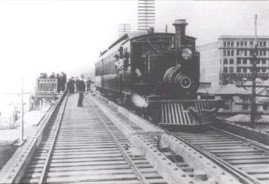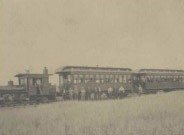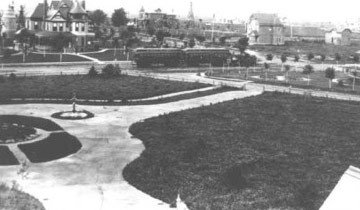Elevated Railway
During the 1880s, the Morningside area of Sioux City began to develop as a pleasant suburb east of the downtown area. It had advantages over the north side. Since it was not as hilly and steep, streets and lots required less grading. Unfortunately, the journey from downtown Sioux City to Morningside was not an easy one. Wagons and buggies had to cross swampy land, the Floyd River and eighty-four railroad and streetcar tracks!
The idea for an elevated railway originated with Sioux City businessman and promoter Arthur Garretson. He owned property in Morningside and would profit if a convenient connection to Morningside could be created. Garretson convinced other local businessmen such as E.C. Peters and William Gordon. Along with Eastern investors, this group of Sioux City promoters organized the Sioux City Rapid Transit Company. The money for the elevated railway was quickly raised, and construction was planned.
The Sioux City Elevated Railway was a grand venture, costing over $586,000 to build. It was the third steam-powered elevated in the world. (In 1892, it was changed to electric power and became the first electric-powered elevated railway in the world.)
Construction began in April 1890, and the line opened for business April 16, 1891. From the elevated Downtown Station at Third and Jones Streets, passengers traveled 22 feet above the ground, east on Third Street, across the Floyd River and south on Division Street. The elevated section then reached ground level at Leech Avenue (near what is now Highway 75) and traveled along the surface out Transit Avenue to Peters Park. The line had two miles of elevated track and three miles on the surface.
The fare was five cents or six rides for a quarter. As a special promotion for Morningside development, families buying a residence in Morningside would receive a year's free pass for the elevated railway.
The elevated railway was successful in opening the Morningside area for development. It even had some unforeseen benefits during the Floyd River Flood of 1892. Many lives were saved when residents were able to climb the stairs up to the tracks and escape the flood waters below. A local hero, Andrew G. Anderson, saved many lives that night by carrying and guiding people to safety at the main elevated station. The flood carried away the steps to the station, so victims had to walk the tracks to others stations to get home.
Plans were being made to expand the elevated line into Riverside and further east into Morningside, but the Financial Panic of 1893 put an end to any expansion. The company went into bankruptcy and the elevated portion of the railway was stopped when the system was reorganized in March of 1899.





